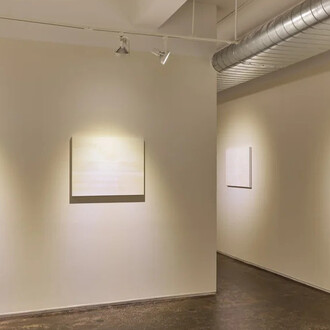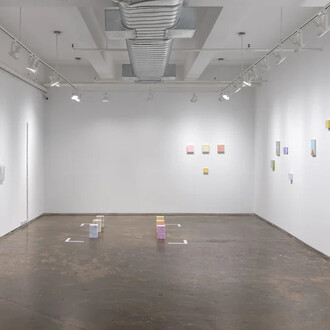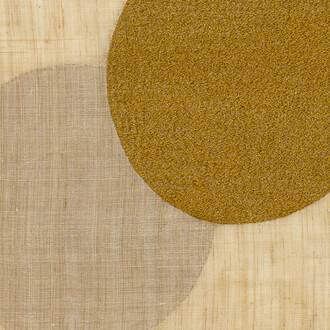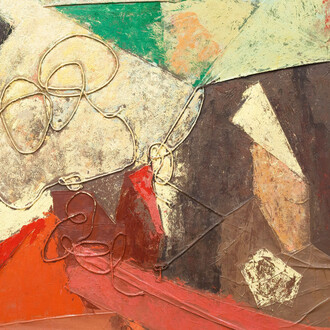Curated in conjunction with Carmen Amengual’s installation in the adjoining gallery, To trace the line where your body cut the air explores the ways information can alternatively be recovered or obscured via memory, personal encounters, architecture, and historical record. Across multiple media including found and staged video, photography, text, sound, and sculpture, the artworks on display embody an ethos of collaboration and collective experience, each following distinct threads present in Amengual’s work. The title takes from a line in Carmen Amengual’s film, A non-coincidental mirror, wherein the artist tried to physically follow in her late mother’s footsteps in order to unearth details of the first Third world filmmakers meeting in Algiers.
The connective pathways of migratory diaspora are central to this exhibition, reverberating amidst the backdrop of the current moment’s ongoing wars. As such, these works are limited by their respective repositories, leaning on the roles of various storage media as the vessels for communication. The artists challenge and uncover the inherent loss—and at times forced entropy—of recordkeeping. Their works explore the intersections between official histories in their idealized form and the messy incompleteness of lived experience, all in relation to various increasingly autocratic infrastructures. Through encounters with strangers, state archives, shared video diaries, and scholarship, the resultant language that circulates appears as fragments, tactics, abstraction, poetics, and warnings against patterns of suppression.
Included in this exhibition are excerpts from Christopher Gregory Rivera’s ongoing project Las carpetas (2014- ), which reimagines political memory in Puerto Rico by rescuing, photographing, and appropriating archives from a secret police division dedicated to political persecution in the US Territory. He is also showing for the first time raw footage from a leaked police video of protests in 2017, highlighting how the practice of political persecution is not only alive and well but increasingly relevant in understanding the current cultures of digital policing. Noor Abed and Mark Lofty’s One night stand (2019) is an experimental documentary based on a real encounter with an unknown European anti-ISIS fighter that was secretly recorded on a cell phone. Through a re-staged simulation of this conversation, the filmmakers probe questions of ideological loyalties to the concept of freedom, distinctions between citizens and soldiers, and the potentials of representation through the documentary form.
Utsa Hazarika’s installation picks up on the investigation in Amengual’s A non-coincidental mirror that examines the potential for architecture to leave impressions on bodies and on memories. In Twilight, two lights (2024), Hazarika appropriates text fragments from postcolonial scholarship, protest chants, news reports, and archival audio from artists and activists from the British Commonwealth and South Asia. These words are refracted through a translucent neon lattice work frame in the form of a disrupted and glitched South Asian jaali–an ornamental patterned architectural screen–as well as available as audio. The combination of the contrasting viewpoints of the text, image, and audio produces a hybrid space where new identities emerge. Departing from the softness of the gesture, Cici Wu’s work uses the techniques and forms of cinema to uncover aspects of archives and microhistories.
The film Belonging and distance is a long-distance collaborative endeavor with Beijing-based queer photographer Yuan Yuan that unfolded from 2022 to 2023. The work weaves together 16mm film fragments with DV video, tracing the indexicality of notions such as “diasporic” and “migratory”. Traversing through scenes from East Broadway Mall in New York’s Chinatown during the pandemic and Beijing in lockdown, family, a memorial site of the June Fourth Incident, Chang’An avenue, Dongdan park, and underground queer parties, the film ends with footage from the cross-harbor tunnel in Hong Kong, which references the siege of Hong Kong Polytechnic University, suggesting a migratory aesthetics as an experimental means of repair.
The contributing artists each speak from different geopolitical contexts and experiences, and yet their work is bound by the implicit solidarity with one another’s histories and continued existence. Together these works gesture towards the stated goals of Amengual’s primary research subject, the first and second Third world filmmakers meetings: to share strategies that run counter to top-down hegemonic rule and norms. The methods employed here do not simply offer solutions to these issues, but claim space to document stories and perspectives, attesting to the soft power of witness. The sentiment marks an attempt to capture the intangible–or at least that which modern methods of documentation cannot hold.
This exhibition is part of the Close readings exhibition series and is curated in conjunction with Carmen Amengual, A non-coincidental mirror, co-presented with the Vera List Center for Art and Politics at The New School. Close readings presents a new commission by one under-recognized, early, or mid-career artist in Gallery One, along with an accompanying exhibition in Gallery Two that uses the central commission as a curatorial framework. This program extends our support for interdisciplinary artists by building conversations around their practices in addition to facilitating the realization of ambitious, site-specific projects.














